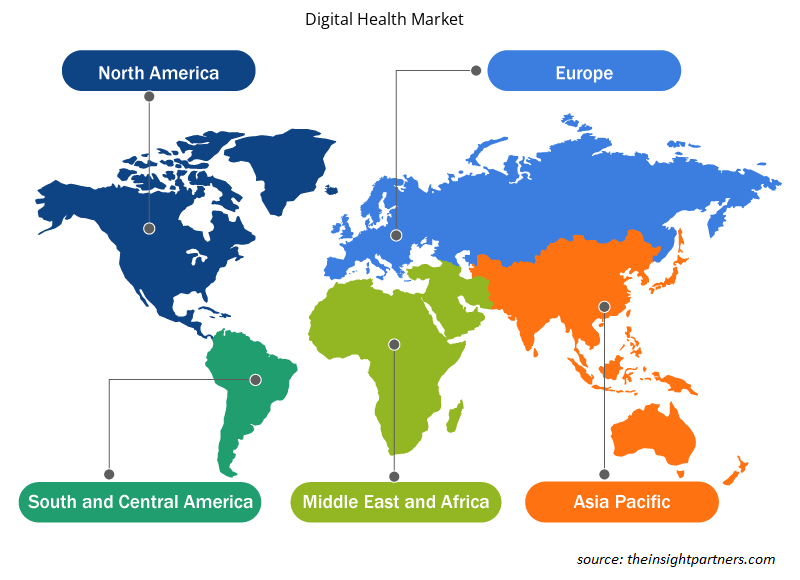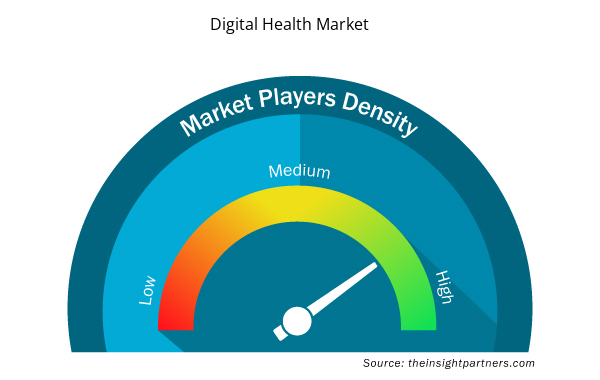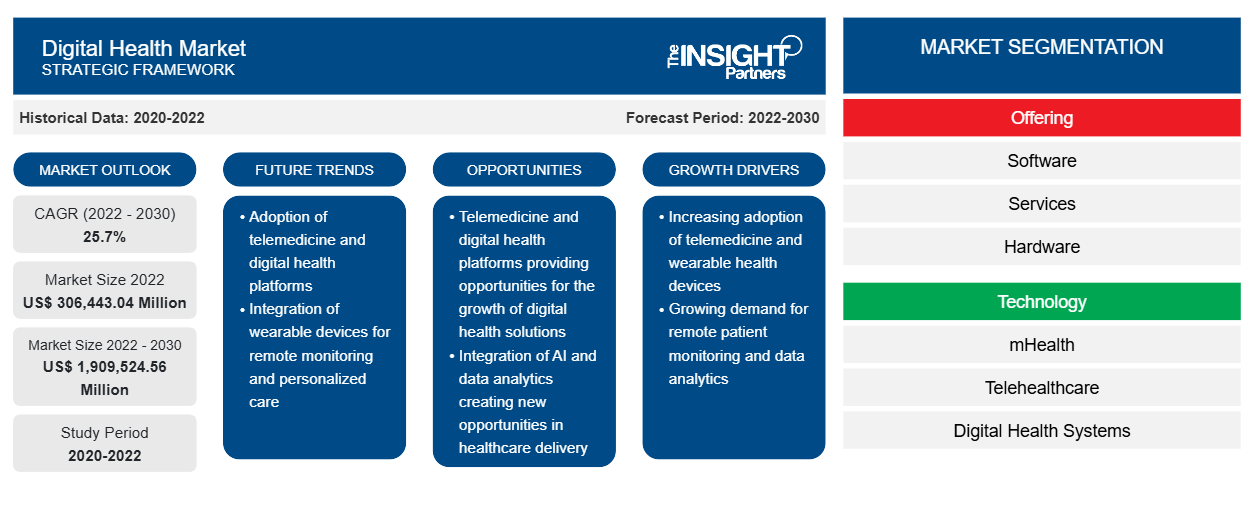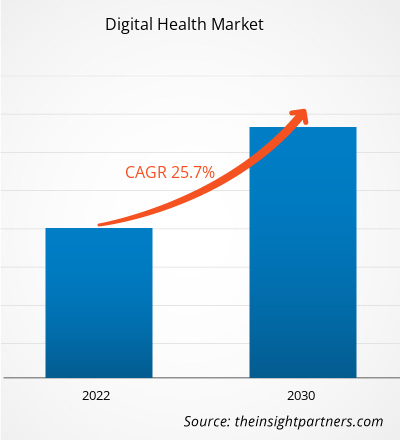[Informe de investigación] Se espera que el mercado de salud digital crezca de US$ 306.443,04 millones en 2022 a US$ 1.909.524,56 millones en 2030; se estima que el mercado registrará una CAGR del 25,7% entre 2022 y 2030.
Punto de vista del analista:
El pronóstico del mercado de la salud digital puede ayudar a las partes interesadas en este mercado a planificar sus estrategias de crecimiento. Factores como el crecimiento del mercado de la salud digital (el aumento de la conectividad a Internet y la penetración de dispositivos inteligentes, el creciente apoyo regulatorio gubernamental y las iniciativas de políticas) y el desarrollo tecnológico en la infraestructura de TI de la atención médica impulsan el crecimiento del mercado de la salud digital. Sin embargo, las preocupaciones de seguridad asociadas con las violaciones de datos y privacidad obstaculizan el crecimiento del mercado.
La salud digital implica el uso de tecnologías de la información y la comunicación en el sector sanitario para gestionar enfermedades crónicas de forma remota. El mercado de la salud digital abarca la salud móvil (mHealth), los dispositivos portátiles, la telesalud y la telemedicina, la tecnología de la información sanitaria (TI) y la medicina personalizada. Ofrece diversos servicios a los consumidores, incluida la identificación temprana de enfermedades potencialmente mortales y el tratamiento de enfermedades crónicas. Los beneficios que ofrece la salud digital tendrán un impacto positivo en el tamaño del mercado de la salud digital.
Perspectivas del mercado:
El creciente apoyo regulatorio gubernamental y las iniciativas políticas impulsarán el crecimiento del mercado de la salud digital
El apoyo regulatorio y las iniciativas gubernamentales son cruciales para dar forma y promover la salud digital. Estos esfuerzos abarcan diversas políticas, regulaciones, mecanismos de financiación e iniciativas estratégicas para mejorar la adopción, la integración y la eficacia de las soluciones de salud digital. Por ejemplo, la Agencia de los Estados Unidos para el Desarrollo Internacional (USAID) prevé utilizar tecnologías digitales para permitir que las personas accedan a información y servicios cruciales, lo que conduce a una vida saludable y próspera. La agencia ha diseñado una directriz de política específica, "Visión para la acción en salud digital", que dirige sus inversiones en tecnologías digitales que respaldan los programas de salud en los países socios. De manera similar, en 2022, el Gobierno de la India lanzó la Misión de Salud Digital Ayushman Bharat (ABDM) para crear un ecosistema de salud digital. Del mismo modo, en octubre de 2021, el gobierno francés invirtió más de 650 millones de dólares para mejorar su infraestructura nacional de salud digital.
Además, la Organización Mundial de la Salud (OMS) define la Salud Digital como “la aplicación de las Tecnologías de la Información y la Comunicación (TIC) a la Salud” en su Estrategia Nacional de Salud Electrónica o Kit de Herramientas de Salud Digital. Según la OMS, en 2020, más del 75% de los proveedores elegibles y el 90% de los hospitales elegibles recibieron fondos por participar en el programa gubernamental que alienta a los hospitales a permitir que los pacientes vean, descarguen y transmitan su información de salud. En mayo de 2020, el gobierno federal de los EE. UU. propuso el Plan Estratégico Federal de TI en Salud 2020-2025 para obligar a los proveedores de atención médica a utilizar EHR.
Por tanto, los factores mencionados anteriormente facilitarán la expansión de la cuota de mercado de la salud digital.
Personalice este informe según sus necesidades
Obtendrá personalización en cualquier informe, sin cargo, incluidas partes de este informe o análisis a nivel de país, paquete de datos de Excel, así como también grandes ofertas y descuentos para empresas emergentes y universidades.
- Obtenga las principales tendencias clave del mercado de este informe.Esta muestra GRATUITA incluirá análisis de datos, desde tendencias del mercado hasta estimaciones y pronósticos.
Segmentación y alcance del informe:
El “análisis del mercado de salud digital” se ha realizado considerando los siguientes segmentos: oferta, tecnología, aplicación y usuario final.
ElEl mercado mundial de la salud digital está segmentado en función de la oferta,tecnología,solicitud,usuario final y geografía.El mercado de salud digital, por oferta, está segmentado en software, servicios y hardware.El mercado de la salud digital, por tecnología, se segmenta en mHealth , teleasistencia sanitaria, sistemas de salud digitales y otros. El mercado de la salud digital, por aplicación, se segmenta enGestión de enfermedades crónicas, salud conductual, salud y estado físico, entre otros. El mercado de la salud digital, por usuario final, está segmentado en hospitales y clínicas, pacientes y consumidores, entre otros. Los hospitales y las clínicas tuvieron la mayor participación en el mercado de la salud digital.
Geográficamente, el informe del mercado global de salud digital está segmentado en América del Norte (EE. UU., Canadá y México), Europa (Alemania, Francia, Italia, Reino Unido, España y el resto de Europa), Asia Pacífico (China, Japón, India, Australia, Corea del Sur y el resto de Asia Pacífico), Medio Oriente y África (Sudáfrica, Arabia Saudita, Emiratos Árabes Unidos y el resto de Medio Oriente y África) y América del Sur y Central (Brasil, Argentina y el resto de América del Sur y Central).
Perspectivas basadas en ofertas
El mercado de la salud digital, en función de la oferta, se segmenta enSoftware, servicios y hardware. El segmento de servicios tuvo la mayor participación de mercado en 2022 y se prevé que registre la CAGR más alta durante 2022-2030.
Perspectivas basadas en la tecnología
El mercado de la salud digital, por tecnología, se segmenta en mHealth, telesalud, sistemas de salud digitales y otros. El segmento de mHealth tuvo la mayor participación de mercado en 2022. Se prevé que el segmento de telesalud crezca más rápido entre 2022 y 2030.
Perspectiva basada en aplicaciones
El mercado de la salud digital, por aplicación, se segmenta en gestión de enfermedades crónicas , salud conductual, salud y fitness, entre otros. En 2022, el segmento de gestión de enfermedades crónicas tuvo la mayor participación de mercado.
Información basada en el usuario final
Según los usuarios finales, el mercado de salud digital se segmenta en hospitales y clínicas, pacientes y consumidores, y otros.El segmento de hospitales y clínicas tuvo la mayor participación de mercado en 2022.
Análisis regional:
Según la geografía, el mercado mundial de salud digital está segmentado en Asia Pacífico, Europa, Medio Oriente y África, América del Norte, y América del Sur y Central.En 2022, América del Norte tuvo la mayor participación en el mercado mundial. Se espera que Asia Pacífico registre la CAGR más alta entre 2022 y 2030.
El mercado de la salud digital en América del Norte está segmentado en Estados Unidos, Canadá y México. La transformación de la atención médica digital y la creciente adopción de soluciones de atención médica inteligentes, incluidas diversas tecnologías como aplicaciones móviles, dispositivos portátiles inteligentes y servicios de salud electrónica como registros médicos electrónicos y servicios de telemedicina, que permiten el monitoreo remoto de pacientes, impulsan principalmente el mercado. Otros factores, como la introducción de tecnologías de software avanzadas en la atención médica, un mayor número de hospitales y la implementación de políticas gubernamentales estratégicas, también ayudan a promover el mercado de la salud digital.
Estados Unidos es el mayor contribuyente al mercado de la salud digital en América del Norte y el mundo. En septiembre de 2020, la Administración de Alimentos y Medicamentos de Estados Unidos (FDA) inauguró el Centro de Excelencia en Salud Digital. Esta creación es un paso importante hacia el compromiso de la agencia de promover el progreso de la tecnología de salud digital. Esto incluye dispositivos de salud móviles, software como dispositivo médico (SaMD), wearables utilizados como dispositivos médicos y tecnologías utilizadas para estudiar productos médicos. Además, la presencia de actores líderes del mercado en el país y sus desarrollos probablemente favorecerán el crecimiento del mercado.
Perspectivas regionales del mercado de la salud digital
Los analistas de Insight Partners explicaron en detalle las tendencias y los factores regionales que influyen en el mercado de la salud digital durante el período de pronóstico. Esta sección también analiza los segmentos y la geografía del mercado de la salud digital en América del Norte, Europa, Asia Pacífico, Oriente Medio y África, y América del Sur y Central.

- Obtenga datos regionales específicos para el mercado de salud digital
Alcance del informe sobre el mercado de la salud digital
| Atributo del informe | Detalles |
|---|---|
| Tamaño del mercado en 2022 | US$ 306.443,04 millones |
| Tamaño del mercado en 2030 | US$ 1.909.524,56 millones |
| CAGR global (2022-2030) | 25,7% |
| Datos históricos | 2020-2022 |
| Período de pronóstico | 2022-2030 |
| Segmentos cubiertos | Al ofrecer
|
| Regiones y países cubiertos | América del norte
|
| Líderes del mercado y perfiles de empresas clave |
|
Densidad de actores del mercado de salud digital: comprensión de su impacto en la dinámica empresarial
El mercado de la salud digital está creciendo rápidamente, impulsado por la creciente demanda de los usuarios finales debido a factores como la evolución de las preferencias de los consumidores, los avances tecnológicos y una mayor conciencia de los beneficios del producto. A medida que aumenta la demanda, las empresas amplían sus ofertas, innovan para satisfacer las necesidades de los consumidores y aprovechan las tendencias emergentes, lo que impulsa aún más el crecimiento del mercado.
La densidad de actores del mercado se refiere a la distribución de las empresas o firmas que operan dentro de un mercado o industria en particular. Indica cuántos competidores (actores del mercado) están presentes en un espacio de mercado determinado en relación con su tamaño o valor total de mercado.
Las principales empresas que operan en el mercado de la salud digital son:
- Corporación Cerner
- Trabajos eclínicos
- Soluciones sanitarias Allscripts Inc.
- Compañía: Honeywell International Inc.
- Sistemas Cisco
Descargo de responsabilidad : Las empresas enumeradas anteriormente no están clasificadas en ningún orden particular.

- Obtenga una descripción general de los principales actores clave del mercado de salud digital
Desarrollos industriales y oportunidades futuras:
- En octubre de 2022, Medulance se asoció con Reliance Jio para lanzar una ambulancia 5G. El vehículo cuenta con dispositivos y cámaras inteligentes y cuenta con comunicación de audio y video bidireccional, transmisión de imágenes en HD, seguimiento de ubicación y transmisión en tiempo real de datos de salud del paciente a un médico distante a través de la red de Internet de alta velocidad.
- En junio de 2021, Amazon lanzó un acelerador de salud digital, AWS Healthcare Accelerator, para apoyar a las empresas emergentes en los sectores de análisis y atención virtual de la salud. El programa prioriza la monitorización remota de pacientes, el análisis de datos, la interacción con los pacientes, la tecnología de voz y la atención virtual.
- En octubre de 2021, Deloitte y Vodafone anunciaron una alianza estratégica para permitir un mayor acceso a la atención sanitaria en toda Europa a través del Centro Vodafone para la Salud con Deloitte. Esta colaboración tenía como objetivo acelerar la adopción de la atención sanitaria conectada. Este centro virtual une las soluciones de salud conectada de Vodafone con la experiencia en consultoría sanitaria de Deloitte para hacer que la atención sanitaria sea más accesible para las personas, independientemente de cuándo y dónde la necesiten.
Entre las empresas destacadas que aparecen en el informe sobre el mercado de la salud digital se encuentran Cerner Corporation, Eclinicalworks, Allscripts Healthcare Solutions Inc., Honeywell International Inc., Cisco Systems, GE Healthcare, Koninklijke Philips NV, Siemens Healthineers AG, Qualcomm Technologies, Inc. y Fitbit, Inc. Estos actores líderes se centran en ampliar y diversificar su presencia en el mercado y su clientela, aprovechando las oportunidades comerciales en el mercado de la salud digital.
- Análisis histórico (2 años), año base, pronóstico (7 años) con CAGR
- Análisis PEST y FODA
- Tamaño del mercado Valor/volumen: global, regional, nacional
- Industria y panorama competitivo
- Conjunto de datos de Excel



Report Coverage
Revenue forecast, Company Analysis, Industry landscape, Growth factors, and Trends

Segment Covered
This text is related
to segments covered.

Regional Scope
North America, Europe, Asia Pacific, Middle East & Africa, South & Central America

Country Scope
This text is related
to country scope.
Preguntas frecuentes
Digital health refers to the implementation of digital technologies in the healthcare industry, including software, hardware, and related services. Several technologies fall under the umbrella of digital health, such as mobile health (mHealth) apps, wearable devices, electronic health records (EHRs), electronic medical records (EMRs), telemedicine, telehealth, and personalized medicine, among others.
The digital health market majorly consists of the players, including Cerner Corporation, Eclinicalworks, Allscripts Healthcare Solutions Inc., Honeywell International Inc., Cisco Systems, General Electric Company, Koninklijke Philips N.V., Siemens Healthineers AG, Qualcomm Technologies, Inc., Fitbit, Inc.
Key factors driving the growth of the digital health market are increasing internet connectivity and smart device penetration, rising government regulatory support and policy initiatives, and technological development in healthcare IT infrastructure.
The digital health market, by end-user, is segmented into hospitals & clinics, patients & consumers, and others. In 2022, the hospitals & clinics segment held the largest market share.
The digital health market was valued at US$ 306,443.04 billion in 2022.
The digital health market, by technology, is segmented into antibacterial drugs, antiviral drugs, antifungal drugs, and others. The mHealth segment held a larger market share in 2022. However, telehealthcare segment is anticipated to register a higher CAGR during 2022-2030.
Trends and growth analysis reports related to Technology, Media and Telecommunications : READ MORE..
The List of Companies - Digital Health Market
- Cerner Corporation
- Eclinicalworks
- Allscripts Healthcare Solutions Inc.
- Honeywell International Inc.
- Cisco Systems
- GE Healthcare
- Koninklijke Philips N.V.
- Siemens Healthineers AG
- Qualcomm Technologies, Inc.
- Fitbit, Inc.
The Insight Partners performs research in 4 major stages: Data Collection & Secondary Research, Primary Research, Data Analysis and Data Triangulation & Final Review.
- Data Collection and Secondary Research:
As a market research and consulting firm operating from a decade, we have published and advised several client across the globe. First step for any study will start with an assessment of currently available data and insights from existing reports. Further, historical and current market information is collected from Investor Presentations, Annual Reports, SEC Filings, etc., and other information related to company’s performance and market positioning are gathered from Paid Databases (Factiva, Hoovers, and Reuters) and various other publications available in public domain.
Several associations trade associates, technical forums, institutes, societies and organization are accessed to gain technical as well as market related insights through their publications such as research papers, blogs and press releases related to the studies are referred to get cues about the market. Further, white papers, journals, magazines, and other news articles published in last 3 years are scrutinized and analyzed to understand the current market trends.
- Primary Research:
The primarily interview analysis comprise of data obtained from industry participants interview and answers to survey questions gathered by in-house primary team.
For primary research, interviews are conducted with industry experts/CEOs/Marketing Managers/VPs/Subject Matter Experts from both demand and supply side to get a 360-degree view of the market. The primary team conducts several interviews based on the complexity of the markets to understand the various market trends and dynamics which makes research more credible and precise.
A typical research interview fulfils the following functions:
- Provides first-hand information on the market size, market trends, growth trends, competitive landscape, and outlook
- Validates and strengthens in-house secondary research findings
- Develops the analysis team’s expertise and market understanding
Primary research involves email interactions and telephone interviews for each market, category, segment, and sub-segment across geographies. The participants who typically take part in such a process include, but are not limited to:
- Industry participants: VPs, business development managers, market intelligence managers and national sales managers
- Outside experts: Valuation experts, research analysts and key opinion leaders specializing in the electronics and semiconductor industry.
Below is the breakup of our primary respondents by company, designation, and region:

Once we receive the confirmation from primary research sources or primary respondents, we finalize the base year market estimation and forecast the data as per the macroeconomic and microeconomic factors assessed during data collection.
- Data Analysis:
Once data is validated through both secondary as well as primary respondents, we finalize the market estimations by hypothesis formulation and factor analysis at regional and country level.
- Macro-Economic Factor Analysis:
We analyse macroeconomic indicators such the gross domestic product (GDP), increase in the demand for goods and services across industries, technological advancement, regional economic growth, governmental policies, the influence of COVID-19, PEST analysis, and other aspects. This analysis aids in setting benchmarks for various nations/regions and approximating market splits. Additionally, the general trend of the aforementioned components aid in determining the market's development possibilities.
- Country Level Data:
Various factors that are especially aligned to the country are taken into account to determine the market size for a certain area and country, including the presence of vendors, such as headquarters and offices, the country's GDP, demand patterns, and industry growth. To comprehend the market dynamics for the nation, a number of growth variables, inhibitors, application areas, and current market trends are researched. The aforementioned elements aid in determining the country's overall market's growth potential.
- Company Profile:
The “Table of Contents” is formulated by listing and analyzing more than 25 - 30 companies operating in the market ecosystem across geographies. However, we profile only 10 companies as a standard practice in our syndicate reports. These 10 companies comprise leading, emerging, and regional players. Nonetheless, our analysis is not restricted to the 10 listed companies, we also analyze other companies present in the market to develop a holistic view and understand the prevailing trends. The “Company Profiles” section in the report covers key facts, business description, products & services, financial information, SWOT analysis, and key developments. The financial information presented is extracted from the annual reports and official documents of the publicly listed companies. Upon collecting the information for the sections of respective companies, we verify them via various primary sources and then compile the data in respective company profiles. The company level information helps us in deriving the base number as well as in forecasting the market size.
- Developing Base Number:
Aggregation of sales statistics (2020-2022) and macro-economic factor, and other secondary and primary research insights are utilized to arrive at base number and related market shares for 2022. The data gaps are identified in this step and relevant market data is analyzed, collected from paid primary interviews or databases. On finalizing the base year market size, forecasts are developed on the basis of macro-economic, industry and market growth factors and company level analysis.
- Data Triangulation and Final Review:
The market findings and base year market size calculations are validated from supply as well as demand side. Demand side validations are based on macro-economic factor analysis and benchmarks for respective regions and countries. In case of supply side validations, revenues of major companies are estimated (in case not available) based on industry benchmark, approximate number of employees, product portfolio, and primary interviews revenues are gathered. Further revenue from target product/service segment is assessed to avoid overshooting of market statistics. In case of heavy deviations between supply and demand side values, all thes steps are repeated to achieve synchronization.
We follow an iterative model, wherein we share our research findings with Subject Matter Experts (SME’s) and Key Opinion Leaders (KOLs) until consensus view of the market is not formulated – this model negates any drastic deviation in the opinions of experts. Only validated and universally acceptable research findings are quoted in our reports.
We have important check points that we use to validate our research findings – which we call – data triangulation, where we validate the information, we generate from secondary sources with primary interviews and then we re-validate with our internal data bases and Subject matter experts. This comprehensive model enables us to deliver high quality, reliable data in shortest possible time.


 Obtenga una muestra gratuita de este informe
Obtenga una muestra gratuita de este informe